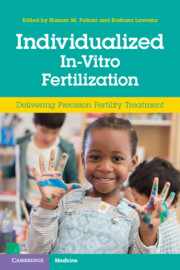Book contents
- Individualized In-Vitro Fertilization
- Individualized In-Vitro Fertilization
- Copyright page
- Contents
- Contributors
- Chapter 1 Individualized Ovarian Stimulation for Normal and High Responders
- Chapter 2 Individualized Ovarian Stimulation in Patients with Advanced Maternal Age and Premature Ovarian Aging
- Chapter 3 Individualized Oocyte Maturation
- Chapter 4 Individualized Luteal Phase Support
- Chapter 5 Individualized Management of Male Infertility
- Chapter 6 Individualized Fertilization Technique in the IVF Laboratory
- Chapter 7 Individualized Genetic Testing
- Chapter 8 Individualized Embryo Selection
- Chapter 9 Preparation for Optimal Endometrial Receptivity in Cryo Cycles
- Chapter 10 Individualized Immunological Testing in Recurrent Implantation Failure
- Chapter 11 Individualized Embryo Transfer
- Index
- Plate Section (PDF Only)
- References
Chapter 4 - Individualized Luteal Phase Support
Published online by Cambridge University Press: 12 February 2021
- Individualized In-Vitro Fertilization
- Individualized In-Vitro Fertilization
- Copyright page
- Contents
- Contributors
- Chapter 1 Individualized Ovarian Stimulation for Normal and High Responders
- Chapter 2 Individualized Ovarian Stimulation in Patients with Advanced Maternal Age and Premature Ovarian Aging
- Chapter 3 Individualized Oocyte Maturation
- Chapter 4 Individualized Luteal Phase Support
- Chapter 5 Individualized Management of Male Infertility
- Chapter 6 Individualized Fertilization Technique in the IVF Laboratory
- Chapter 7 Individualized Genetic Testing
- Chapter 8 Individualized Embryo Selection
- Chapter 9 Preparation for Optimal Endometrial Receptivity in Cryo Cycles
- Chapter 10 Individualized Immunological Testing in Recurrent Implantation Failure
- Chapter 11 Individualized Embryo Transfer
- Index
- Plate Section (PDF Only)
- References
Summary
In ovarian stimulation cycles for IVF/ICSI, a defective luteal phase occurs in almost all patients as a result of the multifollicular development and supraphysiological hormonal levels, which inhibit the LH secretion by the pituitary via negative feedback actions at the level of the hypothalamic-pituitary axis. Progesterone is crucial to induce secretory transformation of the endometrium after previous estrogenization, a process which will finally result in a receptive endometrium. Consequently, luteal phase support (LPS) represents an essential part of ART treatment in case of a planned fresh embryo transfer, as it is crucial to counterbalance the luteal phase insufficiency.
- Type
- Chapter
- Information
- Individualized In-Vitro FertilizationDelivering Precision Fertility Treatment, pp. 39 - 49Publisher: Cambridge University PressPrint publication year: 2021



